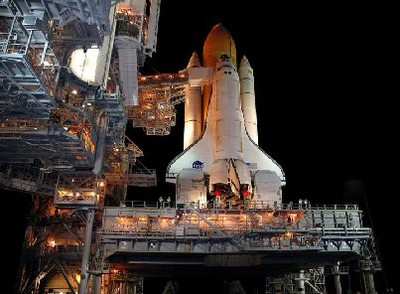Russian Alternative Less Appealing By The Day
 Faced with a five-year gap between the space shuttle's 2010
retirement date and the first manned flight of an Orion space
capsule, NASA is confronted with an increasingly unappealing
choice: continuing flying an aging spacecraft many believe is
inherently unsafe... or cast its lot with a newly resurgent, and
increasingly belligerent, former enemy.
Faced with a five-year gap between the space shuttle's 2010
retirement date and the first manned flight of an Orion space
capsule, NASA is confronted with an increasingly unappealing
choice: continuing flying an aging spacecraft many believe is
inherently unsafe... or cast its lot with a newly resurgent, and
increasingly belligerent, former enemy.
The Associated Press reports NASA recently ordered a quiet study
of NASA's options for extending shuttle flights past the September
2010 retirement date. The study seeks to determine whether the
agency could continue flying the shuttles safely.
"We want to focus on helping bridge the gap of US vehicles
traveling to the ISS as efficiently as possible," wrote John
Coggeshall, manager of manifest and schedules at Johnson Space
Center in Houston, in the e-mail sent last week and obtained by the
AP.
NASA spokesman John Yembrick confirmed the email is authentic,
but adds it's too soon to determine what the outcome of the study
may be. "The e-mail is premature," he said. "The parameters of the
study have not yet been defined."
When President Bush mandated the 2010 retirement date for the
shuttle fleet four years ago, NASA had planned on the first manned
Orion flight to come in 2014... one full year before today's most
optimistic estimates. Back in 2004, Griffin hoped a private
spacecraft provider could help NASA continue flights to the
International Space Station, to complement the agency's plans to
purchase Soyuz capsules to launch itself.
Alas, times -- and in particular, political tensions -- have
changed.
Russia's recent invasion of the former Soviet state of Georgia
has resulted in Cold War-esque tensions in the relationship between
the US and Russia... so it seems increasingly risky to bank
America's hopes for space travel on that country. And so far, there
appears to be little hope for a private spacecraft to arrive in
time to fill the gap.
Both major presidential candidates appear to support extending
the deadline, as well. Republican John McCain joined several
colleagues in the Senate in asking NASA to postpone retirement
activities for at least a year... while his Democrat opponent,
Barack Obama, recently said he wants $2 billion to extend the
shuttle program.
While the Russian situation certainly factored into those
statements... the larger concern to both candidates was likely the
significant job losses along the Space Coast once the shuttle
program ends. In an election year, politicians try to avoid that
subject as much as they can.
Perhaps the biggest question, however, is one of safety. Though
NASA's shuttle launch record has been exemplary following the 2003
loss of Columbia, program managers concede each shuttle launch
carries added risks.

NASA Administrator Michael Griffin has been a vocal opponent of
any proposal to continuing flying the shuttles. "The shuttle is an
inherently risky design. We currently assess the per-mission risk
as about one in 75 of having a fatal accident," Griffin told a
Senate panel in April. "If one were to do, as some have suggested,
fly the shuttle for an additional five years, say two missions a
year, the risk would be about one in 12 that we would lose another
crew."
Those numbers are discouraging... but since the only alternative
seems to be hitching rides onboard Russian Soyuz capsules, even
Griffin may now be willing to discuss extending the shuttle's
lifespan.
 ANN's Daily Aero-Term (04.24.24): Runway Lead-in Light System
ANN's Daily Aero-Term (04.24.24): Runway Lead-in Light System ANN's Daily Aero-Linx (04.24.24)
ANN's Daily Aero-Linx (04.24.24) Aero-FAQ: Dave Juwel's Aviation Marketing Stories -- ITBOA BNITBOB
Aero-FAQ: Dave Juwel's Aviation Marketing Stories -- ITBOA BNITBOB Classic Aero-TV: Best Seat in The House -- 'Inside' The AeroShell Aerobatic Team
Classic Aero-TV: Best Seat in The House -- 'Inside' The AeroShell Aerobatic Team Airborne Affordable Flyers 04.18.24: CarbonCub UL, Fisher, Affordable Flyer Expo
Airborne Affordable Flyers 04.18.24: CarbonCub UL, Fisher, Affordable Flyer Expo




